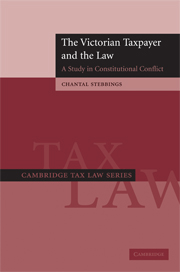Book contents
- Frontmatter
- Contents
- Acknowledgements
- Table of Statutes
- Table of Cases
- List of Abbreviations
- 1 The establishment of the taxpayer's safeguards in English law
- 2 The taxpayer's constitutional safeguards of Parliament
- 3 The administrative safeguard of localism
- 4 Judicial safeguards
- 5 The taxpayer's access to the safeguards
- 6 The taxpayer, the constitution and consent
- Index
4 - Judicial safeguards
Published online by Cambridge University Press: 08 August 2009
- Frontmatter
- Contents
- Acknowledgements
- Table of Statutes
- Table of Cases
- List of Abbreviations
- 1 The establishment of the taxpayer's safeguards in English law
- 2 The taxpayer's constitutional safeguards of Parliament
- 3 The administrative safeguard of localism
- 4 Judicial safeguards
- 5 The taxpayer's access to the safeguards
- 6 The taxpayer, the constitution and consent
- Index
Summary
Introduction
The law provided a threefold judicial safeguard for taxpayers against arbitrary taxation by the state: the strict interpretation of taxing Acts which generally worked to their advantage because it was inherently a limiting and restrictive construction of the legislation; a degree of appeal to the regular courts of law, though not a general right; and the theoretical existence of the judicial review of erroneous adjudicative determinations. These three protective elements of the law applied in principle to all the taxes, direct and indirect. It has been seen that in practice the role of the judges in constituting a safeguard was potentially of considerable value to the taxpayer, but was of limited application at the beginning of Victoria's reign. The nineteenth century was to see an inconsistent attitude to the role of the judiciary in tax matters, with considerable tensions between the public policy considerations of the government and legislature, and the judges' own views of their role in the English legal system.
The interpretation of tax statutes
The literal approach maintained
The principle of consent demanded that a tax be imposed with the agreement of Parliament, and that authority to tax was expressed through the wording of the tax legislation. Its scope had then necessarily to be established, and that task fell to the judges. It was for them to read the statute put before them to find its correct meaning and to ascertain whether it applied to the taxpayer's situation.
- Type
- Chapter
- Information
- The Victorian Taxpayer and the LawA Study in Constitutional Conflict, pp. 111 - 145Publisher: Cambridge University PressPrint publication year: 2009

